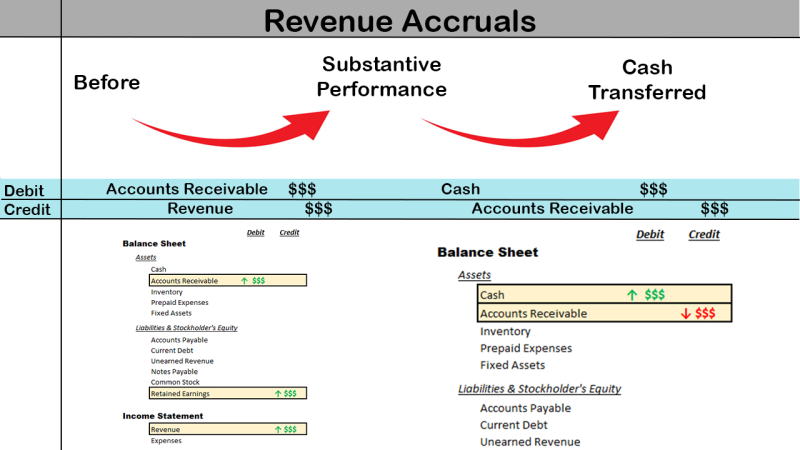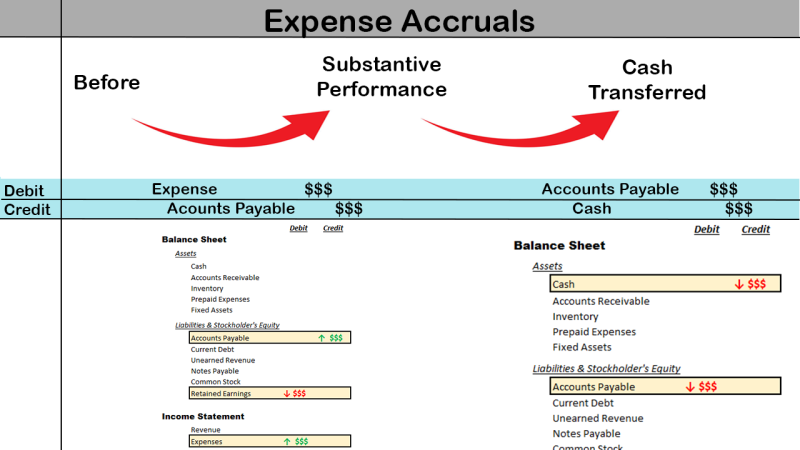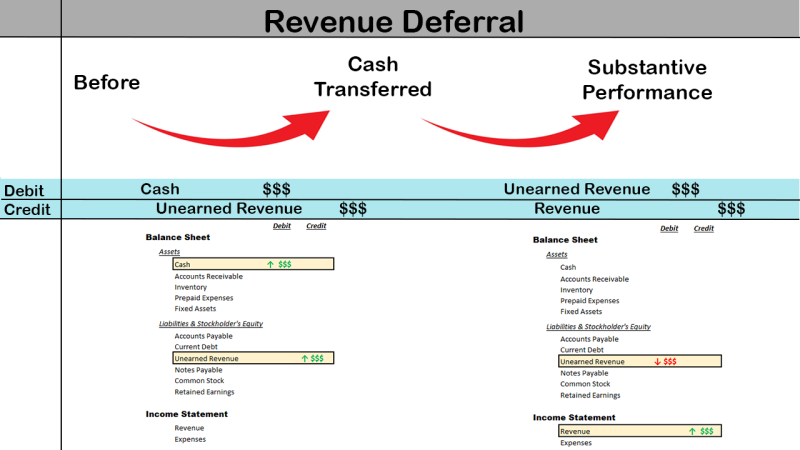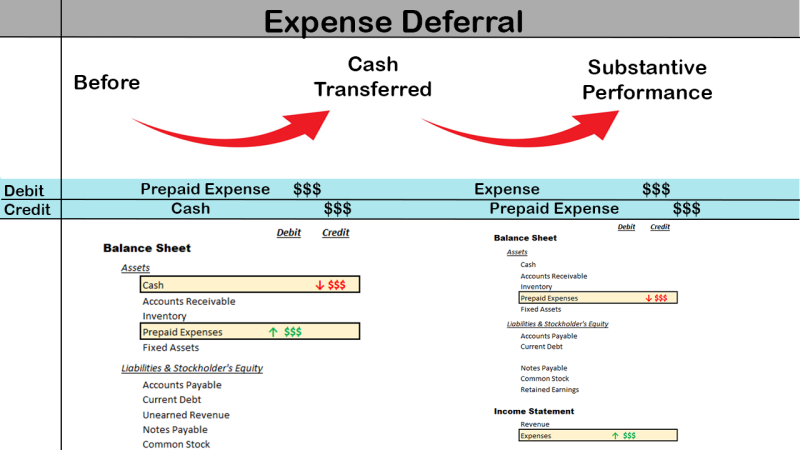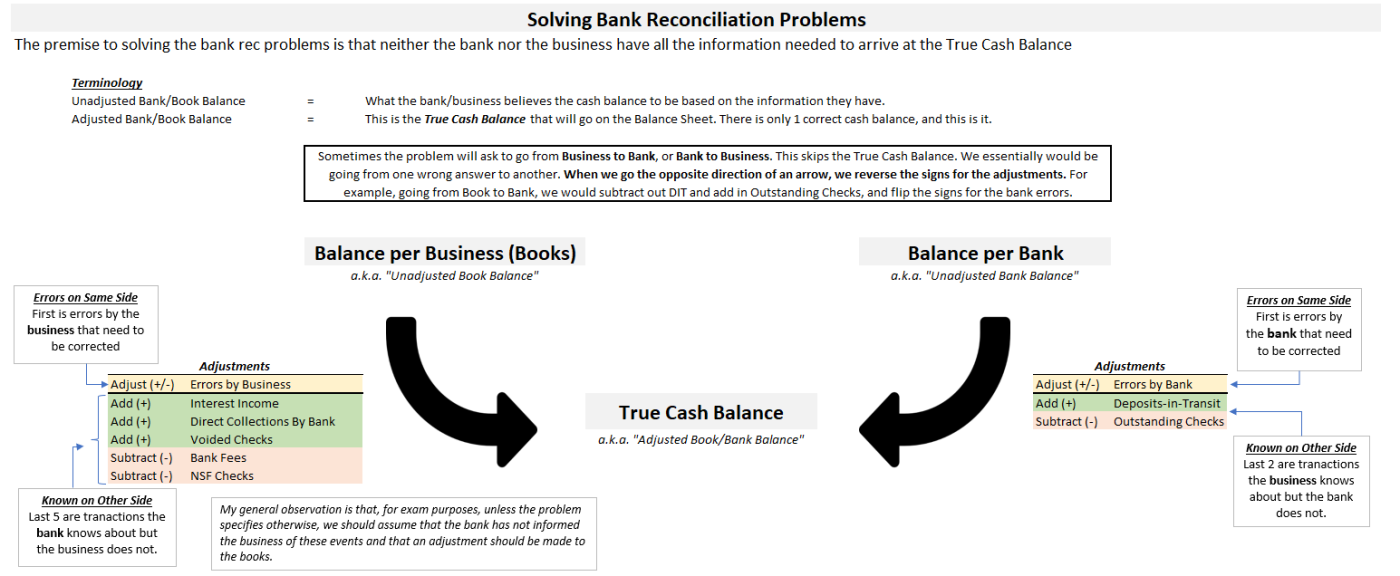Want to sign up and start contributing? Head over to our subreddit at https://www.reddit.com/r/CPAEXAM to get the sign-up code needed.
FAR
Accrual vs. Deferral
Under GAAP, you are required to report on an accrual basis rather than a cash basis. Accrual basis makes it more difficult for companies to manipulate the books using timing differences. Accrual basis records the revenue and expenses based on when "substantive performance" occurs, rather than when the cash transaction occurs. Substantive performance means "when the service is performed."
The difference between the two is:
| Methods | Accrual Basis | Cash Basis |
|---|---|---|
| Revenue | Revenue is recorded to the books when earned. | Revenue is recorded to the books when cash is received or available for use. |
| Expenses | Expense is recorded to the books when incurred. | Expense is recorded to the books when paid. |
Accrual & Deferral both represent the concept of time delay between (1) the transaction occurring, and (2) the cash being transferred.
| Methods | Revenue | Expenses |
|---|---|---|
| Accrual | Revenue is earned today but cash has not been received yet. | Expense is incurred today but cash has not been paid out yet. |
| Deferral | Cash is received today for income that will be earned in the future. | Cash is paid today for expenses to be incurred in the future. |
Note: Don't be misled by the name being "accrual basis" - both accrual and deferrals are terms associated with accrual basis, they just chose to name it "accrual basis".
| Methods | Transaction Occurs | Cash Received / Paid | Description |
|---|---|---|---|
| Accrual | 1st | 2nd | "To Be Paid" |
| Deferral | 2nd | 1st | "Paid in Advance" |
Mnemonic: Accrual - first 2 letters are AC: "Cash After"
These two concepts can be confusing, because the term "deferral" can easily be interpreted the wrong way. You might think of Deferral as "deferring payment", but that is wrong. Think of deferrals as a situation where you might say "I want my money back!". Here are a few examples of each:
- Accrual = "IOU"
- Buying something with a credit card.
- Accepting an IOU from a customer.
- Deferral = "I want my money back"
- Paying college tuition.
- Paying to get into a concert.
- Buying or selling a gift card.
So a business might provide a service, then send an invoice to the client that states payment is due in 30 days. Accrual basis accounting says that the revenue or expense should be recorded on the day the service is performed. So in the period between service performance and payment, there has to be interim account on the Balance Sheet to allow you to record the revenue or expense without changing the cash account. Those interim accounts are:
| Accrual | Deferral | |
|---|---|---|
| Revenue | Accounts Receivable | Unearned Revenue |
| Expense | Accounts Payable | Prepaid Expenses |
Accrual
Notice that substantive performance comes before the cash transaction.
Deferral
Notice that the cash transaction comes before substantive performance.
Balance Sheet
Cash
- Most liquid asset.
- High risk of misappropriation. Requires strong internal controls.
- 3 Types of Cash:
| Term | Types | B/S Classification | Footnote disclosure? |
|---|---|---|---|
| Cash | (1) Cash and Coins (2) Checking Accounts (3) Savings Accounts (4) Money Orders (5) Checks that are signed, mailed, and dated as of the B/S date. * |
Positive Value = Current Asset Negative Value = Step 1: Add up all the cash accounts at the same bank. Step 2: Subtract overdraft amount from same bank. Step 3: List each bank group balance separately on B/S. If a bank is negative, list as current liability. |
|
| Cash Equivalents | (1) Treasury Bills (2) Money Market Funds (3) Commercial Paper (4) CD's |
When you take possession, it must expire in 3 months or less. | |
| Restricted Cash | (1) Bond Sinking Fund (2) New Building Fund (3) Compensating Balance (4) Anything that is "restricted" in it's use. |
Unclear, but it appears to follow the 1 year rule as far as when the cash will become unrestricted. If 1 year or less, then current asset. If greater than 1 year, then non-current asset. |
* See below for situations when checks are not considered cash.
Cash
Checks
Nonsufficient funds checks (NSF) = also known as a bounced check. The check writer does not have enough funds in their account to cover the check.
Postdated checks = when the check has a future date on it. Check cannot be cashed until that date (Usually check will have the date it was written).
Situation when a check is recorded as receivable rather than cash:
- Check hasn't been mailed.
- Check hasn't been signed.
- Check is "postdated", meaning it cannot be cashed until a future date.
- Check is returned as NSF, meaning the check writer does not have enough money in their account to cash the check.
Cash Equivalent
The 3-month rule is applied when you receive the cash equivalent.
- If, at the time you receive the asset, it has 3 months or less until expiration, classify as cash equivalent.
- If, at the time you receive the asset, it has over 3 months until expiration, classify as investment.
Can we reclassify it from investment to cash equivalent when inside 3 months? No
Examples:
- You purchase a treasury bill with 2 years to expiration. Classify as Investment
- You purchase the same treasury bill 1 year later, when it has 1 year until expiration. You hold for 10 months. You want to know whether you can reclassify since it currently has 2 months until expiration. Still classify as Investment.
- You purchase the same treasury bill 1 year and 10 months later, when it has 2 months until expiration. Classify as Cash Equivalent
Restricted Cash
Available For Use is the same as Unrestricted. Restricted means the cash is not available for use.
Some examples of when cash is not "available for use" (a.k.a. "Restricted") includes:
- Check that has not been mailed.
- Check that has been returned as NSF (bounced check).
- Cash set aside for specific fund.
- Cash set aside as a required compensating balance for a loan.
Bank Reconciliations
A bank reconciliation is a report that compares:
- The monthly bank statement and the transactions reported on it, and
- The transactions recorded under the related Balance Sheet account.
The process involves taking the monthly bank statement, which shows all the account activity, and confirming that the transactions recorded in the cash account match up. There are 4 types of transactions that the exam will present to you when asking for bank reconciliations:
| Types of Discrepancies | Info | Terms Used |
|---|---|---|
| Error Made | Illegitimate transactions. Will have to be reversed out. | Erroneously credited, Erroneously Debited |
| Timing Difference: Bank Initiated | Timing Difference transactions where legitimate transactions are initiated by the bank before the B/S Date but the business is not aware of them until after the B/S Date. | Interest Income, Bank Service Charges, Direct Collections By The Bank |
| Timing Difference: Business Initiated | Timing Difference transactions where legitimate transactions are initiated and recorded by the business. Because it will take time for the bank to process these transactions, the bank rec will have to be adjusted for any transactions that are initiated and recorded on the books before the bank rec date, but have not been processed by the bank by the bank rec date. | Deposits-in-Transit, Outstanding Checks |
| Check Events | A check can either be (1) bounced by the bank for insufficient funds from the payor (NSF Checks), or (2) the check could be voided before being cashed (Voided Check). Both of these situations may require an adjustment to the book balance on the Bank Rec. General consensus is that, if the transaction occurs before the balance sheet date, you should assume that the transaction has NOT been recorded on the books, and that an adjustment to the books balance is necessary, unless told otherwise. [1] | NSF Checks, Voided Checks |
| Book Balance | Bank Balance | Type | |
|---|---|---|---|
| Deposit-in-Transit | Correctly Stated | Understated | Timing Difference: Business Initiated |
| Outstanding Checks | Correctly Stated | Overstated | Timing Difference: Business Initiated |
| Service Charges | Overstated | Correctly Stated | Timing Difference: Bank Initiated |
| Interest Income | Understated | Correctly Stated | Timing Difference: Bank Initiated |
QuickBooks
Below is a video that walks through how to do a bank reconciliation in QuickBooks. While this is not a part of the exam, it is useful for doing them in practice.
Investments
2 classes of security investments:
- Equity Securities
- Debt Securities
| Equity Securities | Debt Securities |
|---|---|
| Common Stock | Bonds |
| Non-Redeemable Preferred Stock | Redeemable Preferred Stock |
Preferred stock can be redeemable or nonredeemable. Redeemable is also termed "callable preferred stock". It has a call option attached to it, which will allow the issuer of the stock to buy back (call) the shares back at a pre-determined price. The security class of preferred stock depends on whether it is redeemable or not.
| Equity Security | Debt Security | |
|---|---|---|
| Non-Redeemable | ||
| Redeemable |
Equity Securities
The flowchart below shows which method should be used in valuing the equity security for the financial statements.
This shows the journal entry difference between the Equity Method vs Fair Value Method.
20% to 50%
Investments that consist of between 20% and 50% of the voting stock are considered to have significant control over the investee. The default treatment is to use the Equity method. The investor can also elect to use fair value if made at the right time.
Equity Method
- Initially listed on Balance Sheet at cost.
- See image below for how to calculate B/S carrying value at each year end date.
- What is the Portion of Excess FV over Cost?
- This is calculated using the formula of (Initial Fair Value - Cost) / Life of Asset
- It reduces both the (1) Net Income on the Income Statement, and (2) Carrying Value on the Balance Sheet.
Fair Value Option
- The business can choose to report most assets and liabilities at Fair Value instead.
- Election cannot be made on leases or employee retirement plans.
- Election must be made "on the election date".
- Election made on an "instrument-by-instrument" basis.
- Irrevocable until next election date, if applicable.
- The change in fair value is always recorded in the unrealized gain/loss account, but whether it's reported in the regular income statement or the other comprehensive income (OCI) section depends on whether it's an asset or liability.
File:FairValueOptionIncomeStatement.png
Debt Securities
There are 3 categories for classifying Debt Securities:
- Held-To-Maturity
- Trading
- Available-For-Sale
Held-To-Maturity
- Measured at Amortized Cost.
- Amortized Cost = Cost, +/- the following items:
- Accrued Interest
- Amortization of premium/discount.
- Amortized Cost = Cost, +/- the following items:
